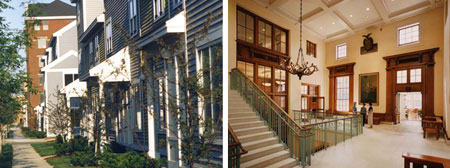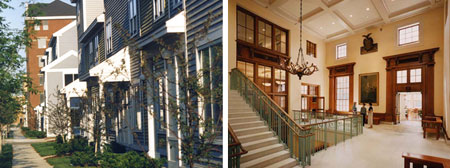by: Linda G. Miller
Event: 2009 Ratensky Lecture Honoring Joan Goody FAIA (1935-2009), with David Dixon FAIA
Location: Center for Architecture, 11.12.09
Joan
Speaker: David Dixon, FAIA — Principal-in-Charge of Planning and Urban Design, Goody Clancy
Moderator: Wids DeLaCour, AIA, Co-Chair, AIA New York Housing Committee
Introduction: Theodore Liebman, FAIA — Principal, Perkins Eastman
Organizer: AIANY Housing Committee
Sponsors: AIANY Planning & Urban Design Committee; with support by The George Lewis Fund

Harbor Point (left) and the Barker Center for the Humanities at Harvard.
Courtesy Goody Clancy
David Dixon, FAIA, principal-in-charge of planning and urban design at Boston-based Goody Clancy, delivered the 2009 Ratensky Lecture — an annual series that honors individuals who have made significant lifetime contributions to the advancement of housing and community design — in honor of his long-time business partner, Joan Goody, FAIA, who passed away several months ago. He was among Goody’s friends, colleagues, and admirers who came to share their memories of her as a mentor, architect, planner, and public advocate. She was the former chair of the Boston Civic Design Commission, president of Boston’s Saturday Club, and recipient of the 2005 Boston Society of Architects Award of Honor for lifetime achievement. “She served the community as well as her profession,” said Dixon.
Goody was the senior member of a firm of more than 100 architects, preservationists, planners, and urban designers. She took the lead on many projects, but once told the Boston Globe in 1986, “There is no single genius in the firm. If someone has a better idea, we use it. We’re more collaborative than most. We try to bring up the next generation.” Her projects include the Barker Center for the Humanities at Harvard, which Dixon said was her “most controversial, but maybe her best.” The project restored and transformed McKim Mead & White’s 1901 Georgia-style Union Building, including a dining area and multi-level cluster of common spaces surrounding a skylit “great stair hall” at the heart of the building. The controversy sparked heated debates about historic preservation versus adaptive reuse, the latter winning out in the end.
What endeared her most to this audience was her belief that people are the building blocks for cities, more than the buildings she and others designed. This is particularly reflected in her urban housing projects. Some notable projects include Harbor Point, where she turned a Boston public housing project into a mixed-income neighborhood for 1,283 families living in new townhouses and mid-rises with renovated three- and seven-story existing buildings. Another project was born out of neighborhood activists protesting the loss of their homes to redevelopment in 1968. The firm worked closely with community groups to design a new mixed-income development for 1,200 people. The firm has been, and is currently, working on the recovery and revitalization of downtown New Orleans and other central neighborhoods covering approximately 20 square miles of the city. Plan elements include replacing public housing and parking lots with a mixed-income, mixed-use community of more than 5,000 people, roughly doubling the district’s pre-Katrina population.
In his introduction to the program, Theodore Leibman, FAIA, principal at Perkins Eastman, called her “an exemplary architect, tireless messenger, and a woman who crashed through the glass drawing table.” According to Dixon, she did not dwell on the fact she was a pioneer, but she certainly was. When she began her career, women practicing architecture was a rarity. In 1970, she helped found an advocacy group called WALAP — Women Architects, Landscape Architects, and Planners. Amie Gross, AIA, of Amie Gross Architects, who was in the audience, recalled vivid memories of interviewing Goody after architecture school in 1975. “I seriously doubted whether I could make it in the profession as a woman and if there would ever be opportunities to practice her firm’s type of architecture. The ease and pride she had as she showed me the work of the firm was my first professional exposure to the architecture of housing which has since been my passion.”
Linda G. Miller is a NYC-based freelance writer and publicist, and a contributing editor to e-Oculus.









